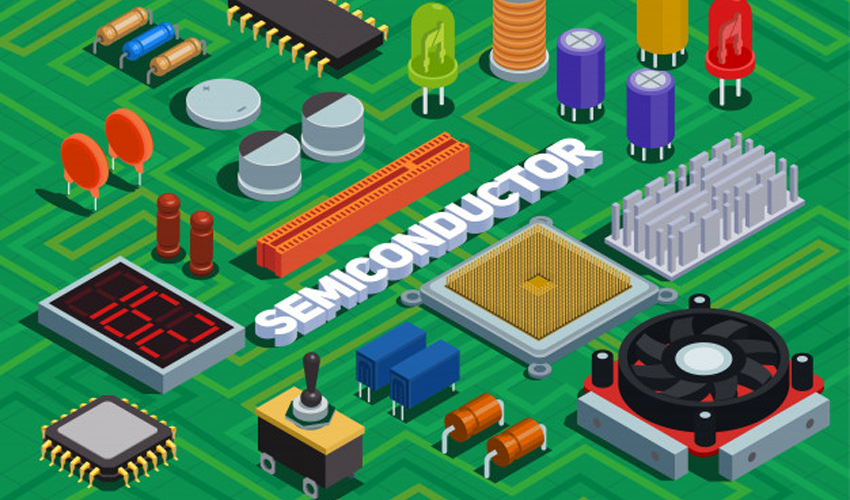
Who knew that such a tiny chip could make a huge difference? President Joe Biden knows. Holding a semiconductor chip in his hand during a recent press conference, the President marveled at how something so little could have such a big impact on businesses and the economy.
“This semiconductor is smaller than a postage stamp, but it has more than 8 billion transistors – 8 billion transistors, 10,000 times thinner than a single human hair in this one chip. These chips are a wonder of innovation and design that powers so much of our country, enables so much of our modern lives to go on – not just our cars, but our smartphones, televisions, radios, medical diagnostic equipment, and so much more,” President Biden said during the conference.
Like Biden noted, these tiny chips – known as semiconductors – are critical to the production of everyday materials that power our daily lives. Things like automobiles, computers, electronic devices, airplanes, medical equipment, and more. But not enough of these semiconductors are being made, causing a massive global shortage, which has significantly affected the manufacturing of consumer goods including televisions, laptops, smartphones, gaming consoles, and new automobiles. Other materials like medical devices, technology, and networking equipment are also hit hard by the shortages.
The crisis caught the attention of the Oval Office.
To address these issues, President Biden recently signed an executive order that will help build more resilient and secure supply chains for critical and essential goods, including semiconductors. The executive order directs a comprehensive 100-day review of supply chains to address vulnerabilities in semiconductor development and advanced packaging, critical minerals, pharmaceuticals, and large capacity batteries, such as those used in electric vehicles.
“We need to make sure these supply chains are secure and reliable,” Biden said. “I’m directing senior officials in my administration to work with industrial leaders to identify solutions to this semiconductor shortfall and work very hard with the House and Senate.” Biden added that he would seek $37 billion in funding for legislation to ramp up U.S. chip manufacturing.
By boosting the domestic production of semiconductors, the Biden administration hopes to prevent future bottlenecks and ensure the U.S. remains less reliant on foreign suppliers.
In an open letter to President Biden, the Semiconductor Industry Association (SIA) urged the president to take action and prioritize funding for semiconductor manufacturing and research. The SIA noted that today only 12% of the world’s semiconductor manufacturing is done in the U.S., a dramatic decrease from 37% in 1990.
This is due to the substantial subsidies offered by governments of our global competitors, which places the U.S. at a competitive disadvantage, the SIA stated.
“We need to stop playing catch up after the supply-chain crisis hit,” Biden said. “We need to prevent the supply chain crisis from hitting in the first place. And in some cases, building resilience will mean increasing our production of certain types of elements here at home.”
The Lowdown on How the Shortage Happened
What caused the global semiconductor shortage? Simply put, Covid-19. The pandemic transformed the way we lived our daily lives – from working and going to school at home, to basically doing everything at home. That increased the need for more computer monitors, speakers, television and home theater systems, keyboards, and video games, as people searched for other ways to entertain themselves at home during the lockdown.
This heightened demand for more consumer electronics caused disruption to the supply chain, as it became increasingly difficult for the supply to meet demand – especially when stay-at-home measures forced many manufacturers to temporarily shut down.
One of the industries feeling the deepest impact of the shortage is the automotive arena. According to a recent article in Bloomberg, the auto industry could lose $61 billion in sales this year from chip shortages.
Semiconductors are becoming increasingly important in the production of new vehicles, as the newer models feature more technologically advanced functions like touchscreen monitors and collision-avoidance systems. But car manufacturers also use older, less advanced semiconductors, like microchips known as eight-inch wafers, for functions like power steering, braking systems, etc.
When the pandemic first hit in spring 2020, new vehicle demand was at a low, causing automakers to cancel orders on semiconductors. But while demand for new cars plummeted, demand for consumer electronics went through the roof – as more people quarantined at home. So manufacturers and suppliers shifted gears in response.
Then, the auto industry quickly rebounded and began ordering semiconductors again, but at that point, there wasn’t enough supply to meet the current demand. The consumer electronics industry had a big jump start, plus the semiconductor shortage was already in full swing – the perfect storm for a disruption to the supply chain.
Find the Right Partner to Turn the Tide
All of these issues underscore the need to build more resilient and diverse supply chains. If you’re a business or an engineer looking to acquire semiconductors or electronic parts, it’s important to have a plan in mind. A good place to start – finding the right distribution partner.
A trusted distribution partner can help you manage and navigate any risks should challenges like semiconductor shortages arise. A distributor offering a diverse supply chain by collaborating across the aisle – from authorized to independent lines – will help you better optimize your supply chain. You will gain valuable chain solutions like materials planning, forecast management, supply chain consulting, sourcing services, and more – everything you need to ensure just-in-time delivery and accomplish your objectives.